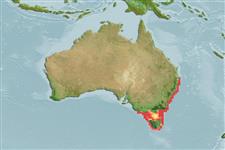Пластиножаберные (акулы и скаты) (sharks and rays) >
Myliobatiformes (Stingrays) >
Urolophidae (Round rays)
Etymology: Urolophus: Greek, oura = tail + Greek, lophos = crest (Ref. 45335).
Environment: milieu / climate zone / depth range / distribution range
экология
морской демерсальный; пределы глубины 20 - 200 m (Ref. 9863), usually 80 - 180 m (Ref. 9863). Temperate; 27°S - 44°S, 141°E - 154°E
Indo-West Pacific: occurs in Australia, from southern tip of Queensland southward to Tasmania. A related or identical species is found off southern Western Australia in deep water.
Length at first maturity / Size / Вес / Возраст
Maturity: Lm ?, range 26 - 31.8 cm
Max length : 44.0 cm TL самец/пол неопределен; (Ref. 9863)
Occurs on the outer continental shelf (Ref. 6871, 75154).
Last, P.R. and J.D. Stevens, 1994. Sharks and rays of Australia. CSIRO, Australia. 513 p. (Ref. 6871)
Статус Красного Списка МСОП (Ref. 130435)
Угроза для людей
Harmless
Использование человеком
дополнительная информация
инструменты
Специальные отчеты
Скачать в формате XML
ресурсы в Интернет
Estimates based on models
Preferred temperature (Ref.
123201): 13 - 20, mean 14.3 °C (based on 14 cells).
Phylogenetic diversity index (Ref.
82804): PD
50 = 0.5000 [Uniqueness, from 0.5 = low to 2.0 = high].
Bayesian length-weight: a=0.00813 (0.00366 - 0.01807), b=3.08 (2.88 - 3.28), in cm total length, based on LWR estimates for this (Sub)family-body shape (Ref.
93245).
Trophic level (Ref.
69278): 3.5 ±0.4 se; based on size and trophs of closest relatives
устойчивость к внешним воздействиям (Ref.
120179): низкий, минимальное время удвоения популяции 4.5-14 лет (Assuming fecundity<100).
Fishing Vulnerability (Ref.
59153): Low to moderate vulnerability (34 of 100).
